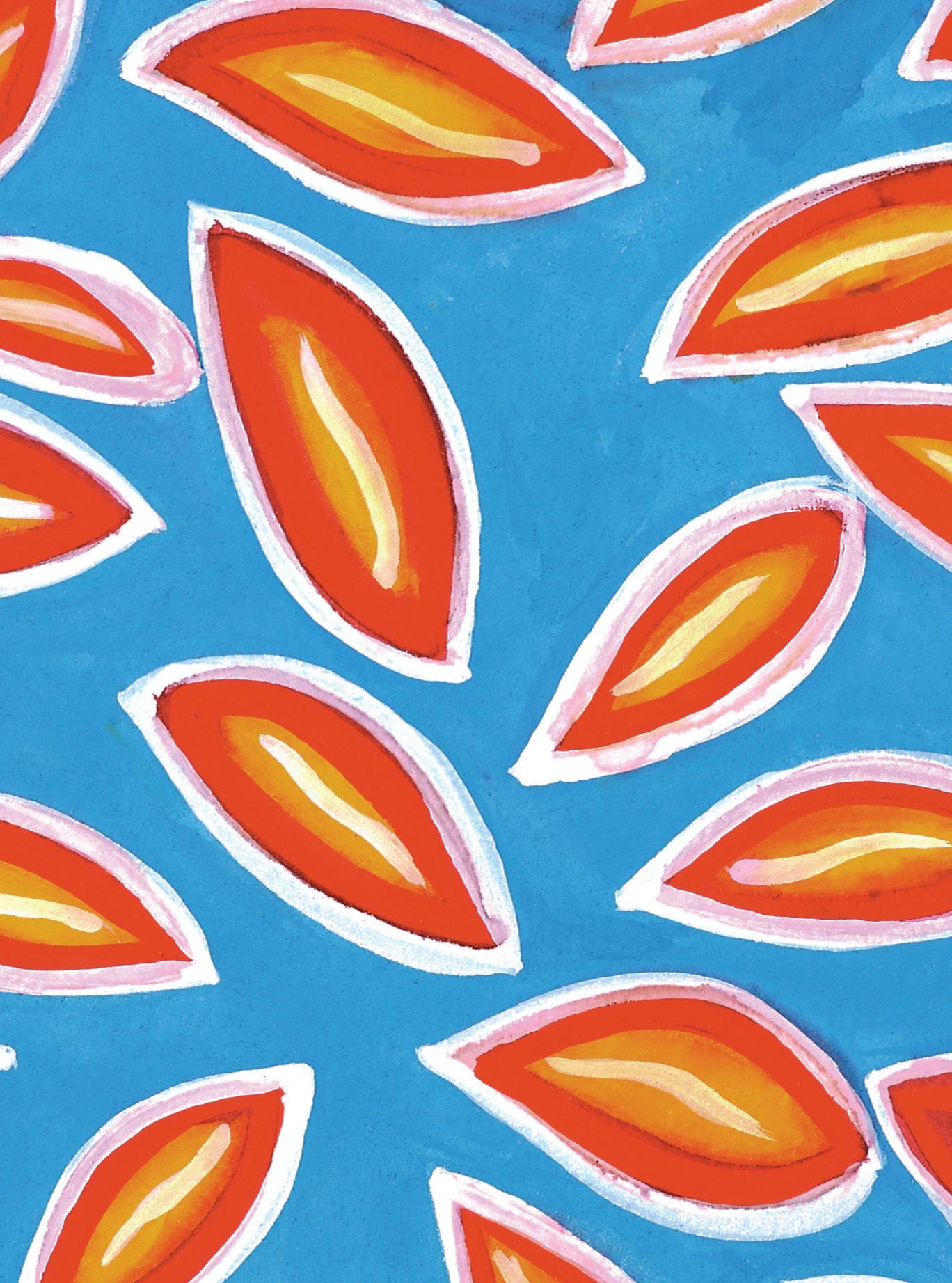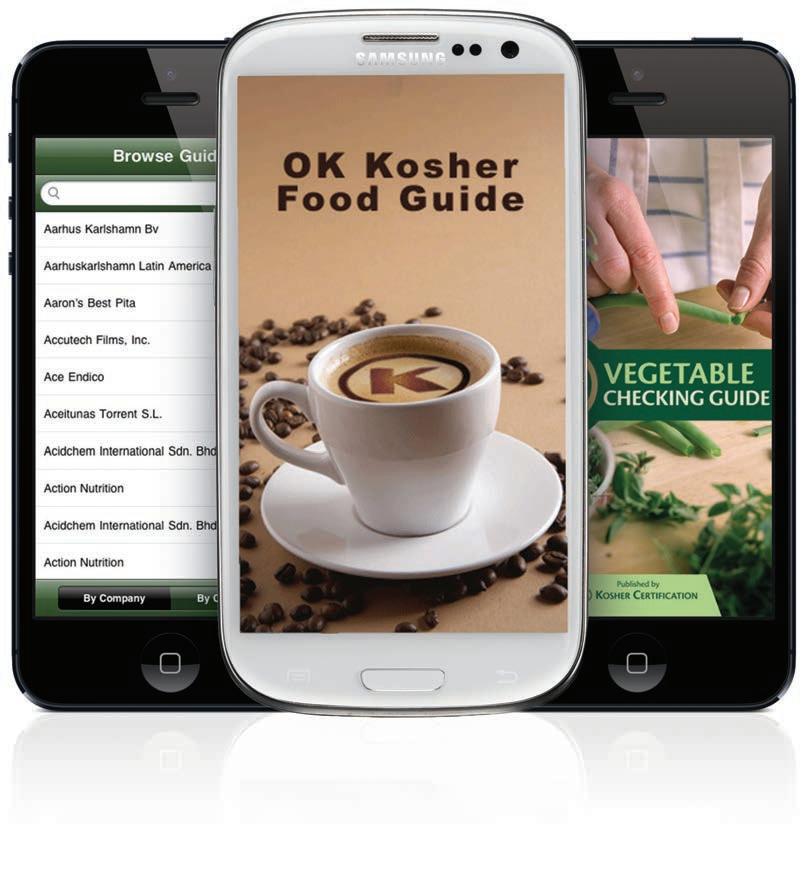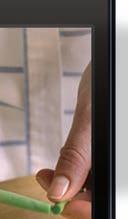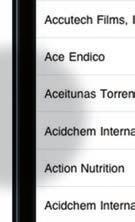HAPPY CHANUKAH!

SHARE YOUR SPIRIT


SHARE YOUR SPIRIT
HEALTHY SPIRIT
OLIVE OIL
By Rabbi BenZion Chanowitz176 ~ KOSHERED YOUR WORLD IN 2015
DUCKTRAP RIVER OF MAINE
FROM THE DESK OF RABBI DON YOEL LEVY
CHANUKAH RECIPE
WHO’S BEHIND THE ~ -RABBI YISROEL SELWYN
FROM GOLUS TO GEULAH
Compiled by Dina Fraenkel
SOUL NUTRITION
By Rabbi Chaim Fogelman
As the cold winter months settle in, nothing can beat good old-fashioned chicken soup. It warms the soul and even heals the body. Then people came around and said that oil and fat are not so good for you…so they cut out most of the oil. Some animal-rights groups said that we should not eat chicken…so they cut out the chicken. Then others said that salt is not healthy…so out went the salt. Next thing you know, the soup was completely watered down and hardly resembled the original, hearty, good old Jewish penicillin.
The Gemara, in Maseches Shabbos, discusses at great length the proper oil for use in the menorah. Back then, the discussions mainly consisted of the different characteristics of the oils, how clean they burned or how they smelled when they burned. However, today, oils, like traditional Jewish chicken soup, are getting diluted and more complicated than ever before. Even extra virgin olive oil might not always be what it seems, as you will see in Rabbi Bentzion Chanowitz’s article about olive oil.
Some people say this watering down is what is unfortunately happening to Yiddishkeit today, like your grandmother’s authentic chicken soup of yesteryear. There are those who want to water down our “taste” and appetite for authentic Yiddishkeit, for Torah and mitzvos. Once it’s watered down, Yiddishkeit doesn’t have the same punch and enthusiasm as in previous generations.
KOSHER SPIRIT Chanukah 5776
EDITOR-IN-CHIEF:
Rabbi Chaim Fogelman
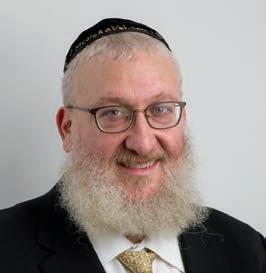
EDITOR:
Dina Fraenkel
DESIGN: Spotlight Design
We welcome your comments, submissions and letters to the editor.
Mail: 391 Troy Avenue, Brooklyn, NY 11213
Email: editor@kosherspirit.com
© 2015. No portion of this publication may be reprinted without written consent from the publisher.
At the ~, we work hard to keep the “fire burning”. We continue to strive to ensure that we don’t cut any corners and we deliver kosher without compromise. It’s our part in preserving Hashem’s Torah and the continuity of Yiddishkeit for future generations.
Wishing you a warm and happy Chanukah,
Rabbi Chaim Fogelman Editor in ChiefOK Kosher & Kehilla Kashrus have merged! Stay tuned for details of the merger featured in the next issue.
Readers share their thoughts...
I just read the Q&A article on “Does beer require a hechsher?” Why is domestic light beer different?
- Seymour W.Dear Seymour ,
Domestic light beers are produced through the use of enzymes. Theoretically if a beer does not have a certification there is a possibility that non-kosher enzymes could have been used to produce the light beer.

-Ed.
I was reading the article in Kosher Spirit which talks about gelatin. It says that gelatin from a cow is pareve due to the process, so I was wondering why the gelatin of fish should not be eaten with meat, assuming its process is the same as from a cow?
- Yosef J.Thank you for taking the time to read my article. Your question indicates that you actually managed to read till the end which is much appreciated.
Meat and dairy can’t be eaten together for kashrus reasons and therefore if meat is rendered halachically “non-meat” then it can be eaten with dairy, as is the case by rennet. However Shulchan Oruch states that we shouldn’t eat fish and meat together because of health reasons; therefore, even if
halachically it could be rendered “non-fish” it is practically still fish and therefore poses a health issue when eaten with meat.
The rule is Chamira Sakanta M’isurra, that we are stricter with hazardous foods than with forbidden foods. If a drop of poison falls into a food mixture we won’t eat it even if the poison is less than a sixtieth of the mixture. Similarly if fish gets mixed with meat, irrespective of the amount of fish that went in the mixture, it can’t be eaten because eating it would pose a health risk.
However the health risk of eating fish and meat together is debated amongst poskim, and although we generally still don’t eat meat and fish together there are poskim that say that we can be lenient with fish gelatin and meat, as you brought up in your question. Since it is a debated topic, I only wrote that one should be aware that marshmallows have fish gelatin, since the topic is an article in itself. I would therefore suggest that one speaks to their personal Rov regarding eating fish gelatin with meat.
-Rabbi RappaportI have a few questions about Bishul Yisroel.
• Does the ~ require Bishul Yisroel on foods that are generally oleh al shulchan melachim (fit to be served at a king’s table), but the specific recipe is not (i.e. potato chips or French fries)?

• What if the food is oleh al shluchan melachim but requires further processing, like canned yams, which are edible out of the can but are usually cooked further before serving?
• Do you allow pilot lights for Bishul Yisroel l’chatchila?
• Do you require steaming to be done by a shomer Shabbos Jew?
The ~ Responds:
The ~ requires Bishul Yisroel for French fries, but we will accept non-Bishul Yisroel potato chips in our restaurants. When the ~ certifies potato chip production, we do require Bishul Yisroel.

If the product is edible straight from the can, we do require Bishul Yisroel.
Usually there is a mashgiach temidi for anything that is Bishul Yisroel, so we do allow pilot lights l’chatchila, but only in the fire or in very close proximity. The mashgiach’s job is to check the pilot lights every morning to make sure they are working and do not blow out easily. For restaurants or caterers that are for Sephardim, we require Bishul Yisroel according to the Beis Yosef and the mashgiach has to put the food on the fire himself.
The ~ does not require steam cooking to be Bishul Yisroel
The ~ receives many letters/emails with kosher questions...
The mitzvah of Chanukah is to warm and brighten the cold outdoor darkness by spreading the holy light of the candles. The cold winter is tough in many ways, especially on our skin. Here are 8 ways to keep your skin warm and glowing.
DRINK PLENTY OF WATER. A HYDRATED BODY IS ESSENTIAL FOR HYDRATED SKIN.
MOISTURIZE DAILY WITH COCONUT OIL.
EAT FOODS THAT ARE HIGH IN VITAMIN E AND OMEGA-3 FATTY ACIDS. BOTH OF THESE ARE ESSENTIAL FOR HEALTHY SKIN.
USE SUNSCREEN WHEN GOING OUTSIDE. IT DOESN’T HAVE TO BE HOT TO GET SUNBURN!
KEEP SKIN COVERED AS MUCH AS POSSIBLE WHEN VENTURING OUTDOORS.
WHENINSIDE,USE AHUMIDIFIERTOMAINTAIN A COMFORTABLE LEVEL OF HUMIDITY IN YOUR HOME.
EATING CITRUS FRUITS, WHICH ARE HIGH IN VITAMIN C, BOOSTS THE BODY’S PRODUCTION OF COLLAGEN, WHICH IS ESSENTIAL FOR HEALTHY SKIN.
TAKE SHORTER SHOWERS AND TRY NOT TO USE VERY HOT WATER.
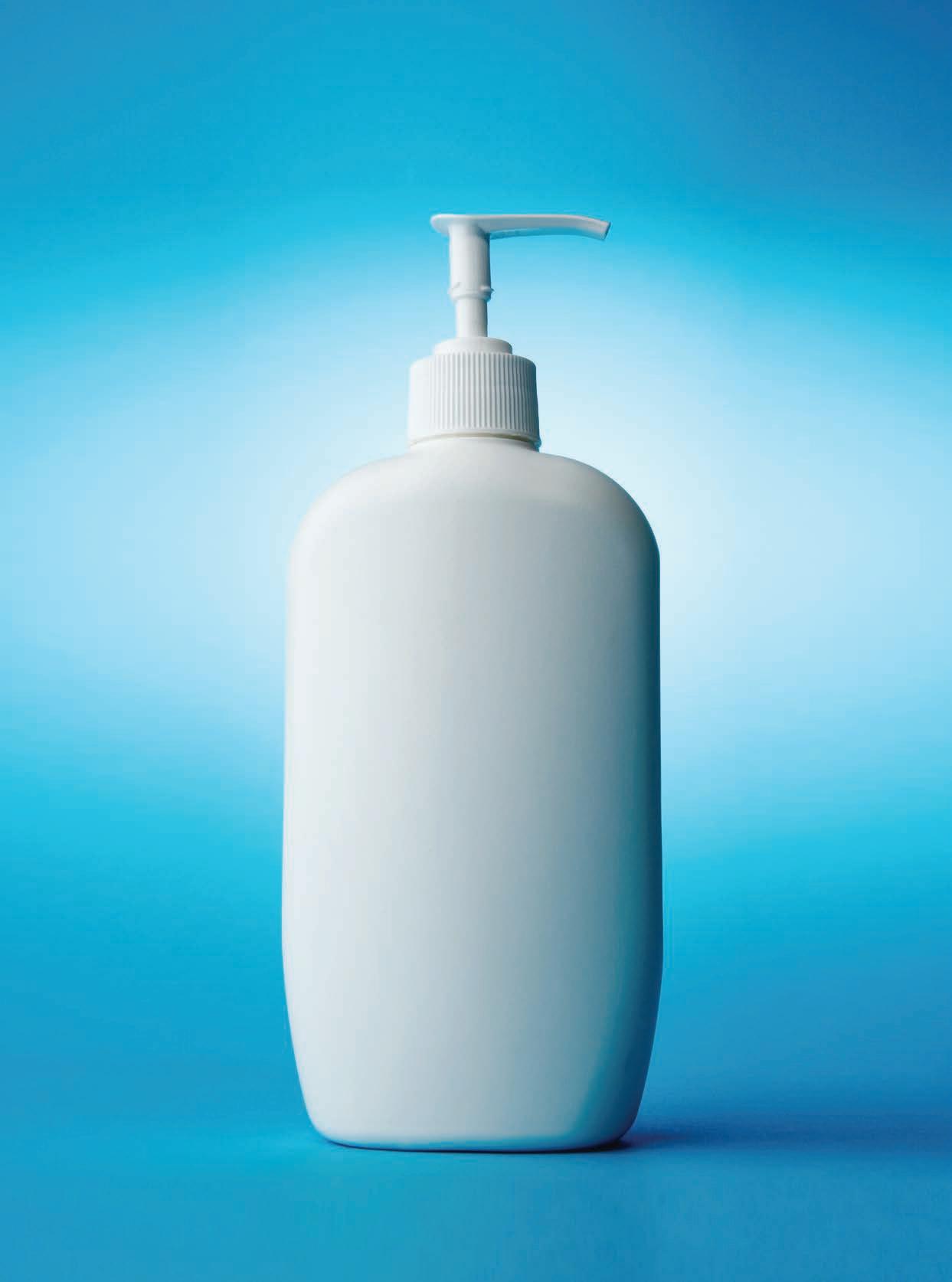
Centuries a go, one of the staple items that was found in most homes was olive oil. Olive oil was used to light up the house, to soften and perfume skin and of course for human consumption. Often meals in those days consisted of bread dipped in olive oil.
Olive oil is relatively easy to make. The olives are pressed so that the oil flows out of the fruit. Well, actually it is olive juice that flows out of the olive. But, after leaving the juice standing for some time, the oil will rise to the top (since it is lighter), while the water will settle at the bottom. Afterwards, the oil is skimmed off the top. Nowadays it is easier to separate the oil by spinning it in a centrifuge.
This process is only able to extract a minimal amount of oil from the olives. At some point in time, producers realized that if they were to grind the olives and then squeeze them using heavy grindstones and wooden beams, more liquid would be expressed from the olives.
Throughout the years, olive oil was known to be kosher.
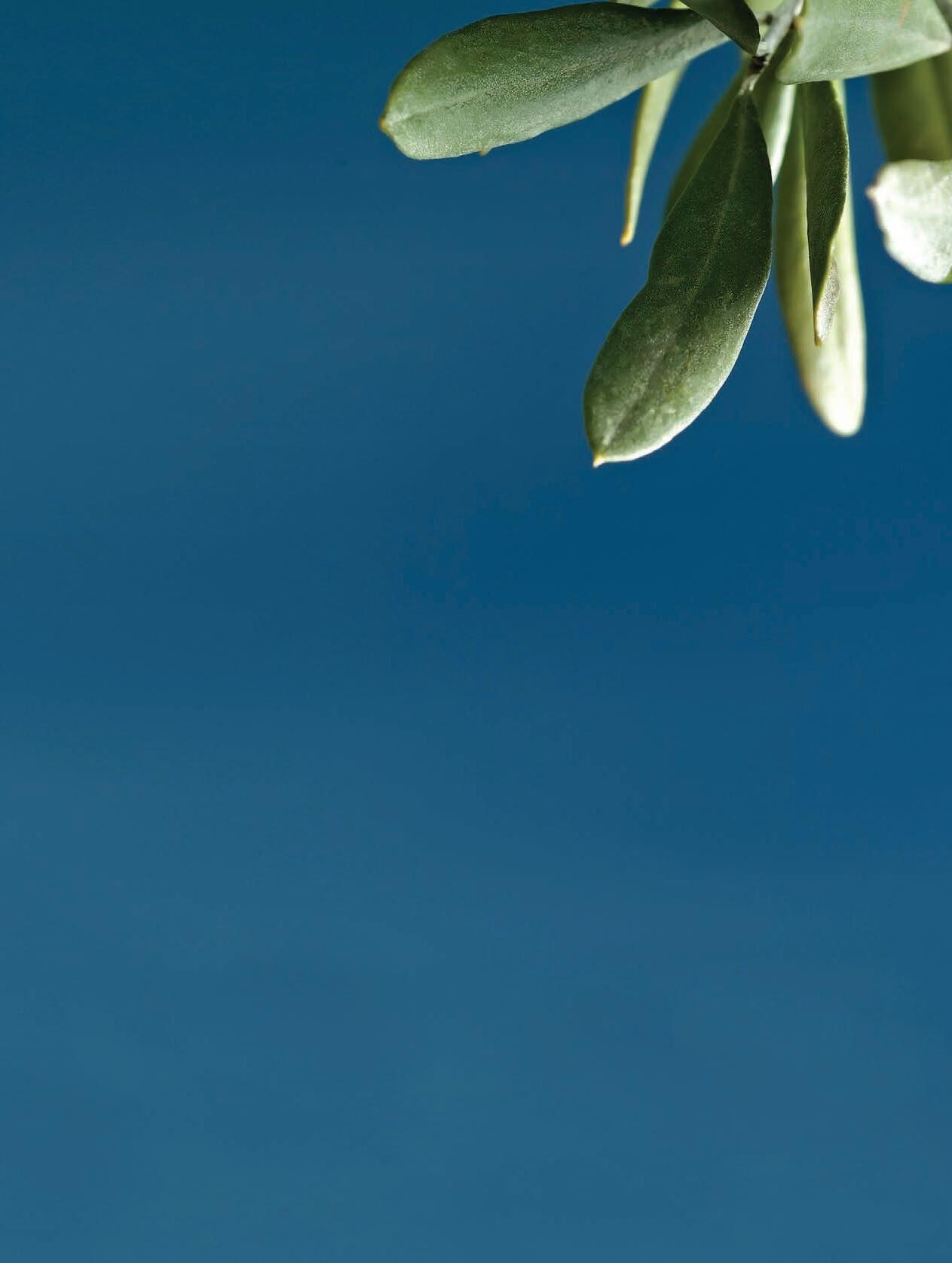
After all, what could be wrong with the oil? It was 100% pure oil that came from an olive!
In the 19th century, and later on as they perfected the process (in 1960), companies began producing oil from vegetables. These vegetables include corn, soybeans, peanuts, hazel nuts, walnuts, sunflower seeds, cotton seeds, cocoa butter, coconuts, and palm. Though many of the above mentioned are not really vegetables, we use the term broadly, as the processing is similar. So how can one extract oil from these vegetables? They cannot be squeezed like olives!
Apparently, if you use a lot of heat and pressure (expeller pressing), or with the aid of chemical solvents like hexane (chemical extraction), you can express oil out of vegetables. This extracted oil is often overly acidic, does not look presentable and may have an “off” smell. To remedy this, the companies usually add chemicals to neutralize the acidity and then separate and remove them. They then bleach the
It is interesting to note the different perspective of today’s society and that of the Torah in the time of the Mishkan. Rabbi Yirmiyaho Kaganoff in his article titled “The Ins and Outs of Olive Oil” quotes the Midrash Tanchuma (Parshas Tetzave 6) who
oil to improve the color, and finally they deodorize it to remove the smell. Since these oils are processed with heat and additives, they would definitely require supervision to ensure that all of the additives are kosher, and that the machinery was not contaminated by unkosher (tallow) productions.
Accordingly, the accepted kashrus policy was that all vegetable oils required reliable kosher supervision, while olive oil did not require hashgocha. This policy was in effect until the manufactures realized that they could produce additional oil from olives if they would use heat extraction. Consequently, after they finished using the cold press on the olives, the remaining pulp would be heated and refined (similar to the processing of vegetable oil), to produce additional oil. This oil was called pomace olive oil, and is often used in sardine cans. Of course this oil would require supervision, just as all of the vegetable oils require supervision, due to the heating process.
Now that even olive oil was produced with heat, how could anybody tell whether they had cold pressed olive oil, or heat processed olive oil? Enter the International Oil Council. In 1991 this respected group began certifying olive oil and assigning various grades, as follows:
1.Virgin olive oil refers to 100% pure cold pressed olive oil (and does not require kosher supervision).
2.Extra light olive oil is the name for olive oil that has been processed by heat and refined (and requires kosher supervision).
3.Pure olive oil is a combination of virgin olive oil and refined olive oil (and therefore requires kosher supervision).
To further complicate matters, virgin olive oil may be sub divided to four categories:

a. Extra virgin olive oil, which means that the olive oil has an acid content of less than one percent. This is considered to be excellent, first quality. Note: there is a limited amount of such oil available.
b. Virgin olive oil has an acid level of less than two percent. This oil has a good taste, but not excellent.
points out that nowadays the superior oil is used for human consumption, while the inferior oil is used for lighting. Yet in Parshas Tetzave, the Torah tells us “Kosis Lamaor”, the oil used for the Menorah must be the purest oil, while the oil used for the
Mincha - meal sacrifice can be of a lesser quality. (Possibly this can be attributed to the Menorah being the source of spirituality and inspiration for the Jewish community. Therefore it must be totally free of any and all impurities.)
This brings to mind the well known Midrash ( Shmos Rabbo Parshas Tetzaveh Chapter 36) “Mah Zayis Hazeh K’shekoisshim Oisoi Hu Moitzee Shamnoi .....”. Just like the way we extract oil from an olive, is by applying much pressure, so too when a lot of pressure is applied to Jewish people, they too produce amazing results. The Jewish people have gone through much squeezing throughout the ages. Many of us personally also feel tremendous pressure at times. The Midrash (while not rationalizing our pain and suffering), tells us, that this may bring us to a more meaningful life! Often the difficulties that we experience, force us to find hidden strengths within ourselves. Often this experience leads us to greater understanding and sensitivity.
c. Ordinary virgin olive oil has a greater than two percent level of acidity. This oil has an inferior taste, and usually ends up being refined.

d. Virgin lamp oil has a severe off taste and is considered inedible. This oil is only used for lighting purposes.
Accordingly, all of the virgin oils may be accepted without any supervision, while the light olive oil, the pomace oil and the pure olive oil would require supervision. There is a problem though, who is enforcing that these standards are being kept? There are few countries that have legally binding laws requiring that the name virgin may only be used by cold pressed oil. Most of the countries (including the United States of America) have no laws about the various standards of olive oil. By and large these are voluntary standards, that companies on their own may decide whether to enforce. Most olives are grown and processed in Crete, Greece, Italy, Morocco, Spain, Turkey, Tunisia, and Israel. These countries have various levels of enforcing the olive oil standards. Even if the label on the bottle says “product of Italy”, this may refer to the bottling of the oil (which may be transported in large containers from other countries). We remain with the question, who is enforc-
ing that the standards of the olive oil are accurate?
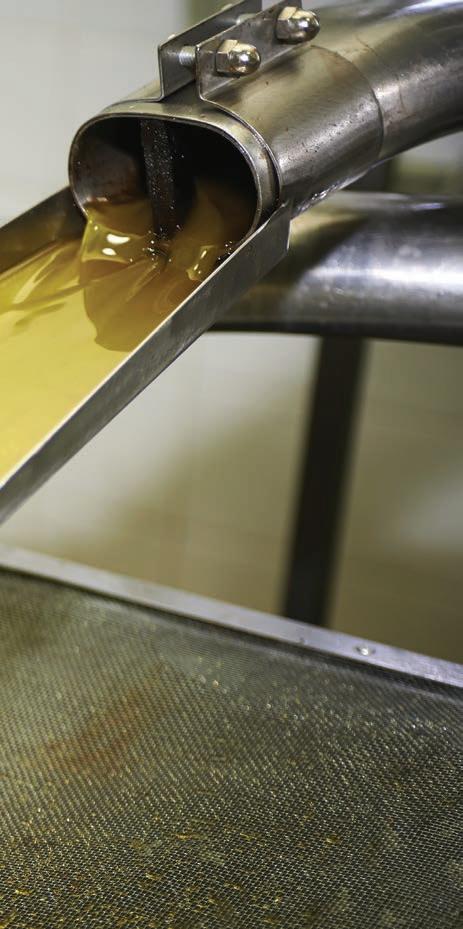
To make matters worse, years ago there were allegations that some companies had compromised on the integrity of their standards of olive oil. Yet, at that time, most kashrus agencies did not consider this a real problem. This was because the allegations were not substantiated. In addition, most of the countries in which olive oil is made do not produce any tallow. Also, most reputable companies would not risk damaging their reputation, by falsifying the International Olive Oil Council’s standards. ~ mashgichim have been visiting our certified facilities in Italy for years and have never found any adulterated oil or false grading during their many inspections.
It is interesting that most kashrus organizations did not insist on requiring kosher supervision on olive oil. In our article we have explored some of the technical is sues involved, yet there is a rich and fascinating history in permit ting the use of olive oil without supervision.
In the first chapter of Daniel, we are told that Nevuchadnetzer tried to raise Jewish children in his palace. He gave them good food to eat, but Daniel refused to eat it. The Gemara (in Mesaches Avoida Zorah 35b-36a) brings down two opinions. Rav says that Daniel decreed that oil that comes from a non Jew is prohibited. His reason was because he felt that if you begin eating food from a non Jew, it may bring closer relations with them. This may ultimately lead to intermarriage. This prohibition also applies to any Jewish person. Shmuel’s opinion is that Daniel’s prohibition was only a stringency he took for himself (possibly as he felt that he was being consecrated to an idol for which he was named Beltshatzar). The decree does not apply to any others.
The Talmud further tells us that the students of Shammai and Hillel (as part of their 18 gezeiros in Mesaches Shabbos) decreed that oil from a non Jew is prohibited. In later generations, Rabbi Yehudah Nesiah (and his Beis Din) nullified the decree. The Gemara asks, “How were they able to nullify this decree? We have a ruling that once a decree has been made and accepted, it cannot be nullified by a latter Beis Din unless they are greater in quantity and quality.” (We assume that any later court is inferior to a previous court.) The Gemara answers that in this case the decree was never accepted by most of the community. Since it
According to Shmuel’s opinion the original reason for the decree was that the olive oil was held in vessels that were used for non- kosher foods. Later on this decree was nullified since any of the non-kosher flavors emitted from the walls of the vessels would not benefit the oil, rather it would ruin its flavor.
The Talmud Yerushalmi relates an incident where Rav did not want to use non Jewish olive oil even after Rabbi Yehudah Nesiah (the grandson of Rabbi Yehudah Hanassi,see Rashi, Tosafos) nullified the decree. Shmuel threatened Rav that if he would not use the oil, he would be considered a “Zakain Mamrai”. Rav relented and used the oil. The Rambam concludes that even if the olive oil is cooked by a non Jew it is permitted. We are not concerned about non-kosher vessels (as it would only ruin its quality), nor the prohibition of Bishul Akum (since it can be eaten raw). In the Rema’s days there was an issue of the olive oil barrels being smeared with nonkosher oils. The Rema concludes ( Shaalos U’Tshuvois #52) not to be stringent in this case. The Aruch Hashulchon (Yoreh Deah Siman 114, s’if 18) says that in his days there was a concern that nonkosher oil was being mixed in the kosher oil. At the end he says, since they tested the oil chemically and said that it was pure, you may use that oil. This may also be the reason that many rabbis hesitate to suspect olive oil of being not kosher.
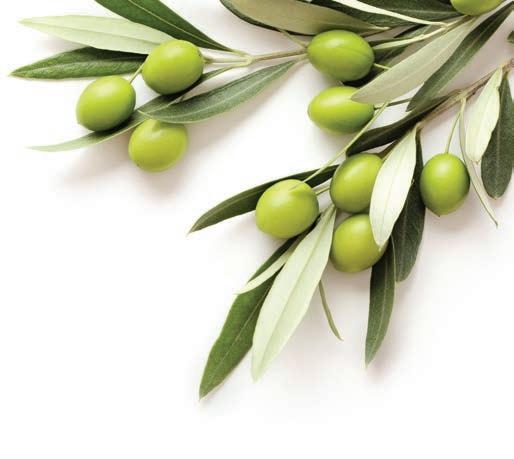
ABUNDANT LIFE FOODS
VIRGINIA
Sugar Free & Gluten Free Products
ACEITERA EL REAL
NICARAGUA
Peanut Oil
ADDIVANT
CONNECTICUT
Pellets
AKRAS FLAVORS GMBH
AUSTRIA
Flavors
ALFA FOODS SA DE CV
MEXICO
Cereals
ALGEA AS
NORWAY
Industrial Seaweed Products
ALL STAR SPECIALTIES
CORP.
NEW YORK
Frozen Desserts
AMAZING TASTE FOODS, INC.
CALIFORNIA
Seasoning Blends
AMISH COUNTRY
POPCORN
Popcorn
ANDEANFLAVORS
ECUADOR
Chocolate Products
ANGROFREEZE CHILE
LTDA
CHILE
Frozen Berry Products
ASHWIN VANASPATI
INDUSTRIES PVT. LTD.
INDIA
Edible Oil Products
ATLANTIC BIODIESEL CORPORATION
CANADA
Glycerin
AWAX DBA AMERICAN OIL COMPANY
CALIFORNIA
Oils & Glycerin
B & C IMPORTS
TEXAS
Coffee
BEER NUTS
ILLINOIS
Flavored Nuts
BEILIU SWEET
TROPICAL FRUIT JUICE
CO., LTD.
CHINA
Tropical Fruit Juices & Puree
Concentrates
BELVAS SPRL
BELGIUM
Chocolate Products
BERG & SCHMIDT
NUTRITION SDN BHD
MALAYSIA
Food Grade Lecithin
BIOENOLOGIA 2.0 SRL
ITALY
Yeast Products
BIOFARMA SPA
ITALY
Probiotics
BLEND LLC DBA
SENSIBLE FOODS
CALIFORNIA
Dried Fruits & Vegetables
BPL TEAS (PVT) LTD
SRI LANKA
Tea Products
BRENNTAG NORDIC
DENMARK
Chemicals
BROOKLYN ARTISAN
BAKEHOUSE
NEW YORK
Artisan Breads
BUNGE MILLING
MISSOURI
Pellet Production
BURGERS BAR BRANDS
INTERNATIONAL
Gluten Free Crunions
CANDYCO, LLC
UTAH
Caramels & Chocolates
CANKER YANKER
NEW YORK
Canker Sore Treatment
CARBAMERICAS, INC.
DBA FROZEN FRUIT S.A.
FLORIDA
Frozen Mango
CATSKILL DISTILLING
COMPANY
NEW YORK
Alcoholic Beverages
CEREAL COMERCIO EXPORTACAO E REPRESENTACAO

AGROPECUARIO SA
BRAZIL
Soy Products
CHALLAH BY ROBIN
TOBIAS
NEW YORK
Challah
CHAM-DUL-NA-RA FOOD CO.
SOUTH KOREA
Sesame Seed Products
CHEMTEX USA
NEW JERSEY
Aroma Chemicals
CHENGDE ASTRONAUT
MOUNTAINOUS PLANT TECHNOLOGY CO., LTD.
CHINA
Fruit Juice Concentrates
CHOCNSWEETS
NEW YORK
Gift Baskets
CHRIS’ COFFEE
SERVICE
NEW YORK
Coffee
CHUNG YANG FOODS CO., LTD.
SOUTH KOREA
Sesame Products
COMERCIAL CHOCOLATES LACASA, SA
SPAIN Chocolate Products
CONACADO
AGROINDUSTRIAL, SA
DOMINICAN REPUBLIC
Cocoa Products
COURTESY PRODUCTS
MISSOURI
Coffee
DAESANG FNF
CORPORATION
SOUTH KOREA
Kimchi
DAIRYMEN’S BEST CREAMY COOPERATIVE
MISSOURI
Dairy Products
DELAFAILLE NV
BELGIUM
Chocolate Products
DICK’S SEED FARM
NORTH DAKOTA
Seeds
DLC DOUGH
FLORIDA
Empenada Shells
DOLCE VITA CREPERIE
NEW YORK
Dairy Restaurant
DUCKTRAP RIVER OF MAINE
MAINE
Smoked Fish
EDVARK LTD.
LATVIA
Fruit Juice Products
EJ DAIRY MARKETING, INC.
WISCONSIN
Cheese
EMPIRE MARKETING
STRATEGIES
OHIO
Decorated Cakes & Cookies
ESTERCHEM SDN BHD
MALAYSIA
Emulsifiers & Stabilizers
EXIMIUS COFFEE
GROUP
TEXAS
Coffee
EXTRACORA LA
FRANCIA
GUATEMALA
Palm Oil
FAMOSO NUT
COMPANY
CALIFORNIA
Almonds
FIVE STAR GIFT
BASKETS
NEW YORK
Gift Baskets
FOOD FRESHLY AFC
GMBH
GERMANY
Antioxidant Dry Mixes
FOUR LINK USA INC.
NEW YORK
Nuts & Dried Fruit
GABY MACHEL
ARGENTINA
Condiments, Relishes, Jams & Spreads
GALFROST LLC
UKRAINE
Frozen Fruits & Vegetables
GALIL IMPORTS
NEW YORK
Chestnuts
GAVELIN
MEXICO
Agave Syrup
GEULA INC. - CAFÉ LAIT
NEW YORK
Dairy Restaurant
GOOD HOME FOODS
ILLINOIS
Cheese Distributor
GREEN VALLEY FOODS
TEXAS
Sprouted Vegetables
H&A COFFEE - GRIND
NEW YORK
Dairy Restaurant
HAN SUNG FOOD CO., LTD.
SOUTH KOREA
Citron Juice
HASCO OIL COMPANY
CALIFORNIA
Lubricants
HEINRICH FRINGS
GMBH & CO. KG
GERMANY
Industrial Vinegar Nutrients
HENAN SENLIN MUHUA
FOODSTUFF CO., LTD.
CHINA
Canned/Frozen Produce
HOJA VERDE GOURMET
HOVGO SA
ECUADOR
Chocolate Products
HOLY SCHMITT
NEW YORK
Horseradish
HOUSE OF SALADS
NEW YORK
Prepared Salads
IBERCACAO, SA
SPAIN
Chocolate Products
IDEALSHAPE
UTAH
Protein Shakes
How did your company get started?
What is the story behind the name “Ducktrap”?
In 1978, an enterprising young man named Des Fitzgerald started Ducktrap as a trout farming operation. After graduating from college, Des was interested in aquaculture so he secured suitable land in Lincolnville, Maine and established a fishery. The land was on the Ducktrap and Kendall Brook Rivers, hence the company’s name,

“Ducktrap River of Maine”. Des’ first foray into the fish business involved a lot of trial and error and didn’t go too well. Forest animals routinely wreaked havoc on the farm and equipment, tearing nets and making quite a mess. Des persevered through this trial and error period and saw light at end of tunnel with the idea of smoking fish and creating a value added item. Des’ little fishery quickly evolved into a smoking operation.
Des started out with trout smoking, using an old wood burning stove buried under the ground in a small hut, which evolved into smoking salmon and other species. Had he not persevered through the initial phase, Ducktrap might not have come into being. Thankfully, he did, and trout and salmon smoking took off.
Ducktrap’s current state of the art facility opened in 1991, a few miles away from the original site. The fa-
Providing kosher certification to a fish manufacturing facility provides all sorts of unique technical challenges. Ducktrap stands out for their efficiency, energy and ingenuity in getting the challenges resolved satisfactorily and quickly. Their commitment to doing things “without compromise” is a true fit with ~ certification and we are proud to work together to achieve our shared aim of providing consumers with the highest in kosher quality.
Due to the particularly kosher sensitive nature of the products manufactured at Ducktrap, the ~ and Ducktrap had to implement some complex systems to ensure kosher products and non-kosher products had no chance of mixing. Ducktrap re-engineered their screens and trolleys so that kosher and nonkosher screens and trolleys would not be compatible. This means that kosher screens and trolleys could not fit into a non-kosher smoker and vice versa. Ducktrap and the ~ worked together to redesign the entire floor plan of the facility to ensure that unpacked kosher and non-kosher products never cross paths.
They underwent an intense kashering process. Even the screens, although they had never been used for non-kosher fish, were kashered before certification was given. We took this extra precaution because we didn’t have complete documentation for each prior use of the screens.
Ducktrap installed double heating elements con trolled by the mashgiach in each of the kilns that do hot smoking. They have battery and generator back-ups, even though the hot smoked fish is gener ally considered edible before the cooking process. Despite the challenge that lay before them, Ducktrap remained focused on the goal of achieving the highest standard of kosher supervision and worked to implement all of the ~ recommendations and safeguards.
cility has 150 employees and smokes several different species of fish, including Rainbow trout, wild mackerel and a variety of shellfish, along with Atlantic and Wild Sockeye salmon. The superb quality standards established in 1978 are the same standards Ducktrap holds sacred today. Keeping with that, we built our previous facility in the 1980s and our current facility in 1991, with a perfect melding of traditional smoking techniques,
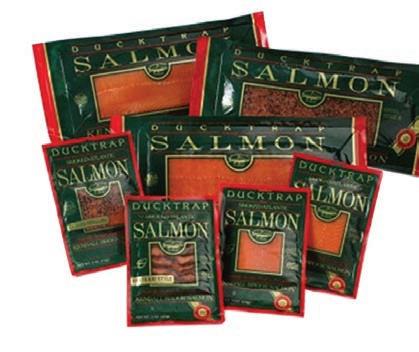
custom brining recipes, state of the art kilns and technology. Maintaining the quality and integrity of our product is of paramount concern and is the core of our culture at Ducktrap.
What makes your products unique? Ducktrap is unique thanks to our story, culture of premium quality, and over 35 years on the Maine Coast. Several employees have been with Ducktrap for over 25 years, which says

a lot about the type of company we’ve built. We have a quality and culture that draws quality people.
The Maine Coast is also a great place to be. It has fresh, clean air and our facility is only a few miles from the ocean. Our four smoking woods – maple, oak, cherry, and apple (two hardwoods and two fruit woods) grow in abundance in this area. We even mill our own wood chips! This smoking blend gives a well-balanced, deli-

a closer look
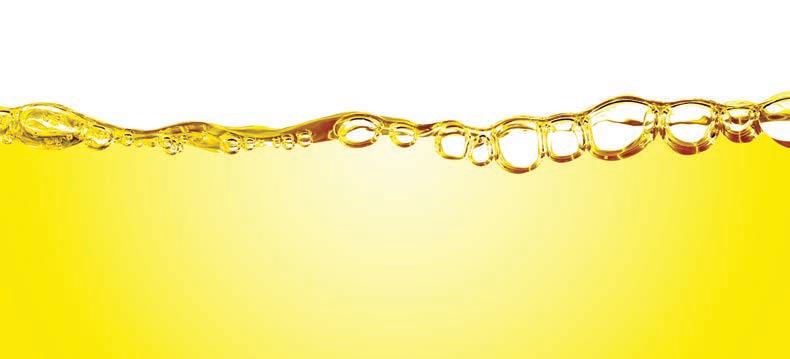 Rabbi Sholom Ber Hendel
Rabbi Sholom Ber Hendel
Vegetable oil is oil that is extracted from various types of fruits, seeds, grains, and nuts (all considered vegetables for this purpose). The most popular oils are made from canola, coconut, corn, cottonseed, olive, palm, palm-kernel, peanut, safflower, soybean, and sunflower. Vegetable oil is used to add flavor, assist with texture, and to cook food.
How is Vegetable Oil made?
Some oils, such as virgin olive oil, are cold pressed which is a very simple process; the olives are pressed, the oil comes out, is filtered, and ready to use. The majority of oils, however, go through a more complex process.
First, the vegetables are crushed to extract the oil. The crushed mixture is then heated and mixed with hexane, a chemical which helps to extract the remaining oil. The solids are removed and used for animal feed, and the hexane is distilled from the crude oil. (Some vegetables are only crushed, while others are flattened, toasted, and only then can the oil be extracted with hexane.)
The crude oil undergoes a refining process to remove the impurities which affect the color, smell and taste of the oil. The refining process consists of three steps: refining, bleaching, and deodorizing (RBD).
Refining: The oil is treated with phosphoric acid, which causes the gums to separate from the oil so they can be filtered out. The oil is then treated with caustic soda, which reacts with the unwanted free fatty acids (FFA) turning
them into soap; the soap is separated from the oil.
Bleaching: The oil is heated and mixed with filter aids, such as diatomaceous earth and clay. These filter aids absorb the coloring and other impurities in the oil. The oil is then filtered to remove the filter aids together with all the impurities.
Deodorizing: The oil is heated under a vacuum to about 480° Fahrenheit. Steam bubbles through the oil, removing the remaining free fatty acids and impurities.
After this process the oil is fully refined and ready to use.
There are two potential kashrus issues concerning vegetable oils: equipment and transportation.
Equipment: The refining process of vegetable oils is similar to the refining process of animal fats and the same equipment can easily be used for both.
Transportation: Crude and refined vegetable oils are often shipped heated, or for longer than 24 hours ( kavush ) in bulk vessels such as tankers, rail cars and ships. The same transport methods are used in the transfer of non-kosher fats and liquids, and this poses a kashrus concern. Once a vessel is used for hot nonkosher products, or the product was in the vessel for more than 24 hours ( kavush ) the vessel is considered non-kosher.
Therefore, vegetable oil, and any product containing vegetable oil, can only be purchased with a reliable kosher certification.
cate and unique taste for our fish.
Ducktrap sources only premium grade raw material. That’s where our standard begins. Our raw material is the major expense in the cost of goods of our product, so it is very important that the fish is premium grade. We also proudly achieved SQF (Safe Quality Food) Level 3 certification, which is the highest level for seafood processors. This international standard gives customers assurances that strict standards in food safety and consistent product quality are in place and followed every day at Ducktrap.
The other aspect that sets us apart is the variety of species, trim styles and seasonings to accommodate different consumers, palates and parts of the market to offer a great variety. Salmon is about 70-80% of business, but we also smoke trout, mackerel and shellfish, as well as offer pates, herring and smoked seafood sauces. Within our salmon offerings, we cold smoke and hot smoke, and there is a tighter, premium trim without veins and brown flesh, along with a value trim which keeps the fillet intact. We have Gravlax, pepper crusted, frozen smoked, fresh smoked – lots of options.
Ducktrap is also part of Marine Harvest, the largest aquaculture company in world. As such, we are able to purchase through Marine Harvest, which has the highest standards for raw materials and gives us great access to a quality supply chain.
What would you say is your biggest success?
That’s a hard question and I’ll give you a multi-faceted answer. On one hand, we always feel like our biggest success is when we receive an email or call from a satisfied customer complimenting a particular Ducktrap product or sharing a wonderful experience they had with one of our products. We are all about premium quality and when that feedback comes back from a customer, large or small, we feel like that is always among our biggest success stories.
Awarding several employees with 25 year recognition is also a big success for us as an organization. It shows that we are doing something right to keep experienced people at our company and growing with us.
Ducktrap has also experienced six years of consecutive growth that is both our greatest challenge and biggest success at same time. Growing 10-20% each year since 2009 is quite an undertaking but we are very proud that the market has responded to our product so well.
What has been your greatest challenge, in addition to managing your growth?
Our greatest challenge is finding more qualified and talented people to join Ducktrap. Anticipating the price of salmon, which goes up and down and is quite volatile in world markets, is also a significant challenge. The price of salmon affects our final product pricing quite a bit because such a big portion of our production costs is raw material. We always want to make product as affordable as they can be for many people, but sometimes
the price depends on the market for salmon. We source fish from around the world – Chile, Iceland, Scotland, Norway, Argentina, the US, etc. – and choosing premium raw material from around the world is quite a challenge.
What prompted you to pursue kosher certification?
We were previously certified by another kosher certifying agency, but based on both customer input and market realities, we saw a need to have a kosher certification that appealed to the broadest range of consumers and shared our focus on providing the highest quality and level of supervision. In short, we needed a certifying agency with a premiere well recognized symbol, so we chose the ~.
~ Kosher’s certification is a distinctive aspect that sets Ducktrap apart from other smoked fish companies. The ~ helped us make the necessary improvements and supports our focus on premium quality as an internationally recognized kosher symbol with high standards and supports our commitment to premium quality smoked seafood products.
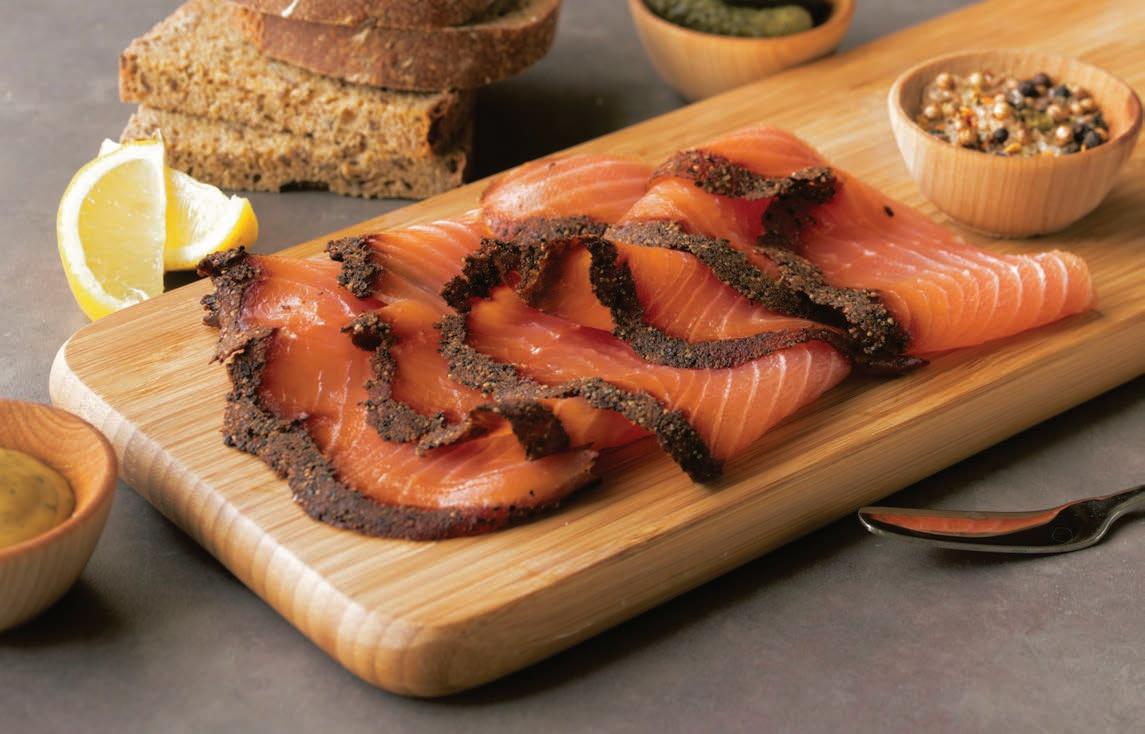
Describe your relationship with ~ Kosher.
Dustin Batley, our Plant Manager, and one of the main liaisons between Ducktrap and the ~, shares “The ~ has been an excellent organization to work with. They have been attentive to our needs as a production facility, while maintaining their high standard for kosher certification. The ~ staff at all levels has been supportive, helpful, and informative both during the initial process of koshering, as well as with their follow up visits and attention after our certification. It is a good partnership.”
Where is your product available for purchase?
Ducktrap products can be purchased in premium supermarkets across the country. Our products are usually found in a refrigerated cooler adjacent to the fresh seafood counter or section.
To read more about Ducktrap River’s history and smoking process, and for a detailed guide on where to purchase, please visit www.ducktrap.com.

Food production has advanced by leaps and bounds over the past century. Commercial production is much more than mixing basic ingredients together to create a product. Just like food coloring is added to many products to add or enhance the color, today most commercial food products rely on manufactured flavors, both “natural” and “artificial” to make the product taste great. Whether the flavor is completely synthetic, or has natural components, the production is a complex process.
ON A RECENT TRIP TO EUROPE I visited a flavor factory to see if it met our kosher standards. Flavor producers are one of the more versatile types of producers in the food industry. A standard factory will usually focus on one type of production; for example, a bakery will usually have baking equipment, a candy factory will have candy producing equipment, a chocolate producer will have chocolate equipment, etc. On the other hand, a flavor facility can have multi-faceted types of production areas requiring different expertise. Flavor companies also have thousands of ingredients and can produce tens of thousands of different formulae.
Flavors are produced in a variety of different ways. There is cold production and hot production. Cold and hot production is further divided between liquid production and dry production. To add to the complexity, a typical flavor house usually utilizes multiple different types of production in the same facility!
In a liquid production, the mashgiach is focused on making sure both the ingredients and equipment are kosher.
If a non-kosher production is done before the kosher production and the method is only cold production, all that is needed is a thorough cleaning to make sure that the equipment is not contaminated with actual non- kosher ingredients.
If the non-kosher ingredients used were cold, but held in the equipment for 24 hours or more, then according to Halacha the ingredient is considered absorbed into the equipment and the equipment must be koshered in the event that the kosher product will remain in the equipment for 24 hours, or will be produced with heat. This is because the equipment will have absorbed the non-kosher or dairy taste and the machinery will contaminate the kosher product.
In the case of a very strong, sharp tasting non-kosher ingredient (for example, a wine-based, strong non-kosher alcohol) the ingredient can be considered absorbed in a much shorter period of time and would also need koshering.
Without going into great detail, koshering would generally consist of cleaning the equipment, having it sit idle for 24 hours, and then filling it with water and bringing that water to a rolling boil, following with a cold rinse.
In a flavor house, they are constantly producing dif-
ferent flavors with different ingredients so the mashgiach checking the kashrus of this equipment has to have access to what is being produced on this equipment in order to be able to know when non-kosher products have been in the equipment for over 24 hours. This means that he must have access to the company’s records, which usually means computer records in today’s high-tech world.
If the mashgiach doesn’t have access, then he will have to kasher the equipment before producing any products that will remain on the equipment for more than 24 hours (even if it’s a cold process) or any production involving heat.
Another facet of cold production is dry blending. This involves powders that are mixed together in blenders. The kosher concerns in dry blending are that the previous product could be non-kosher, or could be dairy. If non-kosher was produced first and then one wants to produce kosher, then of course the equipment must be thoroughly cleaned and cleaning powder out of all the pipes and crevices can be quite challenging. In addition, if one wants to produce pareve, then one must ensure that that the equipment has been thoroughly cleaned from the dairy product prior to use.
Here again, we must have access to the company’s records in order to know the sequence of production. This will usually require the mashgiach to be computer savvy, so that he will be thoroughly familiar with the company’s records and data management system.
This is only a short synopsis of the cold production to give you some insight into what is required of the mashgiach in the cold department of the flavor company.
According to Halacha, if non-kosher is produced hot on the equipment, the equipment is considered non-kosher. Anything subsequently produced on this equipment is considered non-kosher. Even if all the ingredients are kosher, if dairy is produced via hot methods, the piece of equipment now obtains a dairy status and anything produced on this equipment is considered dairy. In “hot” equipment we have many different types of equipment presenting us with different challenges. Whereas originally “cooking” involved only simple pots or ovens, today
we have many different ways of producing “hot” products. We still have the standard way of cooking items in a pot. However, whereas our ancestors put a pot on a fire and cooked, today the fire is not usually in the production area. The fire is in a huge boiler that produces steam that is piped to an enclosed jacket surrounding the pot and this steam heats up the pot.
Kosherizing this pot is usually quite easy with a thorough cleaning, down time of 24 hours and then filling to the top and bringing to a rolling boil. However, according to Halacha, when two liquids share a common (metal) wall they are considered connected. Therefore the steam that was heating the non-kosher product becomes nonkosher and must be addressed before we can even think of koshering. The halachos and procedures involving nonkosher steam is an entire article unto itself and cannot be further addressed here.
Other types of heating equipment include pasteurizers, heat exchangers or similar types of equipment. These are closed systems that heat the products, which does not allow us to actually see the water boiling during koshering. The solution here is to know the altitude at the facility and at what temperature water boils at this altitude (the higher the altitude, the lower the temperature required
Whereas originally “cooking” involved only simple pots or ovens, today we have many different ways of producing “hot” products.
to reach boiling). For example, at sea level water will boil at 212ᵒ Fahrenheit or 100ᵒ Celsius. In Denver, Colorado, the mile high city, water will boil at 203ᵒ Fahrenheit or 95ᵒ Celsius. Then the mashgiach checks the temperature to ensure it reaches that boiling point via a thermometer, which is usually built in to the piece of equipment.
Another type of flavor production is what we call Maillard reaction production. To quote from Wikipedia:
The Maillard reaction (/maɪˈjɑr/ my-yar; French pronunciation: [majaʁ]) is a chemical reaction between amino acids and reducing sugars that gives browned food their desirable flavor. For example, seared steaks, pan-fried dumplings, cookies, breads, toasted marshmallows, and many other foods undergo this reaction. It is named after French chemist Louis-Camille Maillard, who first described it in 1912 while attempting to reproduce biological protein synthesis.
The reaction is a form of non-enzymatic browning which typically proceeds rapidly from around 140 to 165 °C (284 to 329 °F). At higher temperatures, caramelization and subsequently pyrolysis become more pronounced. The reactive carbonyl group of the sugar reacts with the nucleophilic amino group of the amino acid, and forms a complex mixture of poorly characterized molecules responsible for a range of odors and flavors. This process is accelerated in an alkaline environment (e.g., lye applied to darken pretzels), as the amino groups (RNH 3 +) are deprotonated and, hence, have an increased nucleophilicity. The type of the amino acid determines the resulting flavor. This reaction is the basis of the flavoring industry.
Koshering from a Maillard reaction also requires bringing water in the equipment to a rolling boil, as described above.
Another more complicated type of production used in flavors and in other types of production is the drying of liquids until they turn into powder form. This is usually done by what is commonly known as a spray dryer tower, which is a huge inverted cone that has the product coming in from the top through an atomizer in either hot or cold form. The liquid spray is confronted by a blast of superheated hot air and falls to the bottom in a powder form.
This piece of equipment is quite complicated to kasher if first used for non-kosher ingredients (or dairy ingredients when pareve is needed) and the methods cannot be discussed within the limits of this article.
Another type of dryer is what we call a vacuum dryer, which creates a vacuum to decrease the air pressure and force the water to evaporate at a lower temperature (similar to water boiling at a lower temperature at higher altitude where there is less air, as described above). This can be done in one stage or several stages. The advantage of this method is that the product will not “burn” at the lower temperature and its taste will not change due to the drying process. A product dried through the vacuum method can be done without any heat, eliminating the need for koshering. However, where heat is used, the equipment must be koshered through boiling, as previously mentioned.
The above methods are just a brief glance at the complex production methods and equipment used at a flavor facility. These concerns are in addition to the many thousands of ingredients that are used in a flavor house. The ingredients alone require special monitoring using an advanced computer system.
The ~ also has a full time staff in our main office monitoring the tens of thousands of products that these companies produce. First and foremost, these employees determine, via a complex data system AND rabbinic review, whether the formula is kosher. If it is a kosher formula, then the product is classified as pareve or dairy and a rabbi determines whether the production equipment requires koshering before production of this particular product.
The ~ has many flavor houses where we have full time mashgichim monitoring the systems there, in addition to the full time employees in our office. We have special systems set up to monitor the receiving of all ingredients (in all certified companies) to ensure that only acceptable ingredients make it into the approved areas in the companies, as well as many checks and balances and individual procedures tailored to the unique realities in each facility. This multi-faceted and custom designed approach makes every product certified by ~ Kosher Certification “kosher without compromise”.
 By: Shifra Klein - Joy of Kosher Magazine. Subscribe at www.joyofkosher.com/subscribe
By: Shifra Klein - Joy of Kosher Magazine. Subscribe at www.joyofkosher.com/subscribe
BASIC PASTA DOUGH:
1 cup Double 00 flour
1 whole egg
1 egg yolk
1 tsp. extra virgin olive oil
FILLING:
2 medium butternut squash, peeled, seeded, and large diced
3 tablespoons plus 1 tablespoon olive oil
1 cinnamon stick
2 sprigs of thyme
6 tablespoons tahini paste
1 tablespoon black and white sesame seeds, toasted
2 tablespoons date honey
Kosher salt and black pepper
Make a small well in the middle of the flour.
Add the egg and egg yolk to the center.
Gently incorporate flour and egg together until dough forms.
Do not over knead.
Brush with olive oil.
Wrap in plastic and refrigerate for at least one hour.
Pasta can then be rolled out into thin sheets using a wooden dough roller:
Begin by dusting work surface with semolina or all-purpose flour.
Start from the center of the dough and roll towards each side until dough is 1/8th inch thin.
Pasta can then by cut using the tip of a knife or pizza slicer into strip shapes (spaghetti, linguini, fettuccini, tagliatelle etc.)
TO MAKE RAVIOLI: Cut pasta sheets into 2 inch strips
Place filling directly in center of one strip spaced 2 inches apart
Filling can be place in with spoon or piping bag
Brush edges with whisked egg mixed with water (egg wash)
Gently place another strip over.
Use a fork to crimp the edges and press out any air bubbles.
For circle shapes use cookie cutter. For square shapes cut with knife or pizza
TO MAKE FILLING:
1. Toss butternut squash in 3 tablespoons olive oil and season with salt and pepper.
2. Place thyme sprigs and cinnamon stick on roasting pan with squash.
3. Roast at 425°F for 35 minutes (or until golden brown).
4. Puree squash with tahini and season with salt and pepper.
5. This puree will serve as the filling. Any remaining puree will serve as the sauce.
6. Follow the above directions for making ravioli.
7. Cook in a large pot of boiling water for 3 minutes. Reserve some water to help thin out the sauce.
8. Immediately toss with sauce/remaining puree. Add reserved pasta water if necessary.
9. Top with toasted sesame seeds and date honey. Pour flour onto clean work surface (cutting board, countertop)
KS: Where did you grow up? Where did you go to yeshiva?
RYS: I grew up in the Stamford Hill area of London. I studied in the Chabad yeshivos in Manchester, London, K’far Chabad, Israel and Morristown, New Jersey. From there I was sent on shlichus to the Chabad yeshiva in Caracas, Venezuela and then finished my studies at the Central Lubavitch Yeshiva in Crown Heights, where I received semicha.

KS: What did you do after yeshiva?
RYS: I married my wife, Chana (nee Stock), in 1997 and I worked in Judaica and then started my career at the ~ in the Data Entry department.
KS: What is your current position at the ~?
RYS: : I am currently a Senior Account Manager and Legal Coordinator, responsible for overseeing certain customer accounts, making financial decisions and managing the many aspects of contract development and other legal document maintenance that a structured certifying body requires.
KS: What prepared you the most for your current position at the ~?
RYS: I am naturally a precise and detail oriented person…
maybe partially as a result of my English origins! In addition to these qualities and a proficiency in mathematics, I actually started working at the ~ 17 years ago and I worked my way up from Data Entry, to managing the entire Data Entry department for nine years. My previous positions at the ~ taught me a lot about how the ~ interfaces with certified companies, the complex inner workings of our data systems, and also left me with experience in the many areas of kosher certification requiring legal intervention and services.
KS: What is best thing about working at the ~?
RYS: My favorite part about working at the ~ is the family atmosphere and the care and appreciation that management shows. It is this warm, community environment that encourages employees to put their best foot forward and aids in securing committed, long term hires.
KS: How would you describe the ~ today?
RYS: The ~ is a kosher organization that is globally respected, on top of their game and, no matter what, never bends the rules when it comes to kashrus decisions. It is these qualities that consistently rank the ~ among the top kosher certification agencies worldwide, trusted by millions of consumers and thousands of certified companies.
KS: Can you share an interesting experience that you had while working at the ~?
RYS: I’m based in the ~ headquarters in New York, so I don’t really travel much and have stories like the other rabbis who work here. I would like to say however, that I recently broke my leg and was out of commission for quite a while. During this time, the ~ management made sure that my last worry was my work, job security, etc. They made sure to alleviate all of my outside stresses. Even when I returned, they went out of their way to help me get back into the work routine, and for that I’m forever grateful.
However, if I may bring you back to my early days in the data department. This was a time that our rabbis would review each formula on paper. As we like to under promise and over deliver, there was a time when one of our flavor companies had a time sensitive project and Rabbi Levy offered to pitch in with the formula review. The look on his face when I staggered in with a stack of papers which probably reached my nose was priceless! It goes without saying that he put in the hours and reviewed each formula. Thank G-d, we are now paperless and formula review is now done online.
Rabbi Yisroel Selwyn
“ Yisroel has come up in the ranks to be one of the pivotal personnel in our office. In his quiet, persistent, and persevering manner his accomplishments amaze us.”
Rabbi Don Yoel Levy
Kashrus Administrator
“ Yisroel is someone who only knows how to ‘do it right the first time’. Personally, I have learned a lot from him over the years. He may not even realize how many others were affected by his dedication and positive personality.”
Rabbi Levi Marmulszteyn
Rabbinic Manager
“ In the kashrus field, we must be on top of endless details to meet the challenges that occur as a result of changes or new findings. There are always ‘must do’s’ when it comes to ensuring kashrus compliance and Reb Yisroel Selwyn, in his role of Senior Account Manager and Legal Coordinator, earns the respect of anyone who comes in contact with him. Our international team knows Yisroel will make the process clear and comprehensible for the benefit and betterment of improving kashrus. A pleasure to have him as a part of our team!”
Rabbi
Eli Lando Chief Customer Relations OfficerThe ~ is a kosher organization that is globally respected, on top of their game and, no matter what, never bends the rules when it comes to kashrus decisions.
There are three different ways that people view the Torah. Some say that the stories in the Torah are merely symbolic and should not be taken as truth, chas v’sholom. The traditional opinion is that every story in the Torah is absolute truth and is an actual record of events. The third view is that of Chassidus. In Chassidus and Kabbalah it says, “The Torah speaks about the upper realms and alludes to the lower realms.”1 In plain English, this means, every story in the Torah records an actual event, but that event is much more significant than the actual physical event. It has ramifications and parallels in the spiritual world. Each event in the Torah, since it transcends the limits of time and space, relates to every Jew, at every stage in history.
Parshas Mikeitz, which is always read during Chanukah, centers on Yosef’s release from prison. According to Chazal, Yosef is representative of the entire Jewish people.2 Yosef’s name means “increase”, which can be explained as an infinite potential for growth3, as every Jew possesses a neshamah that contains a cheilek Eloka mi’ma’al mamash4 (an actual part of Hashem) and Hashem is not limited.
Yosef’s prison symbolizes the body and our existence in the physical world, which both serve to limit and constrain the limitlessness of our neshamos, concealing the Gdliness that exists in everything. Yosef’s release from prison alludes to the end of limits. He ceases being a prisoner and becomes the second most powerful man in Egypt. Yosef’s
rise represents the mission of every Jew in this world. We are all here to reveal the G-dliness inherent in every aspect of the physical world, from the minutiae to the greatest events. Sometimes, there are limits that constrain this ability, but they are always temporary. Just as Yosef rose from prisoner to viceroy, each one of us becomes a beacon of light, showing G-d’s existence and Providence in this world, through our thoughts, speech and actions.
The name of the parsha, Mikeitz, can actually mean “at the end”5 or “at the beginning”6, which raises the question of whether “mikeitz” is the end of Yosef’s struggles, or the beginning of his triumph. One opinion states that it refers to his challenges, since the darkness is most intense right before the dawn.7 The other opinion states that it is the beginning of Yosef’s triumph. Despite the difference of opinons, both interpretations of “mikeitz’” are connected. Even the darkest moments of golus are G-dly and contain actual sparks of Hashem. Facing and overcoming this darkeness releases the G-dliness and ushers in the first moments of geulah. 8
May Yosef’s journey from golus to geulah be a mirror for our own times, as we face these terribly dark and cold moments before the dawning of the brightest lights that will shine forth with the everlasting Geulah Shleimah bimheirah v’yameinu.
5. Rashi in our Torah reading.
6. See the gloss of Rav Avraham Ibn Ezra to Numbers 13:25, Deuteronomy 15:1, 31:10, Psalms119:96. See also the gloss of the Maharsha to Niddah 58b.
7. Likkutei Dibburim, Vol. I, p. 68a, b [English trans. p. 150].
8. This enables us to appreciate the interrelation between the name Mikeitz and the Torah reading which follows. Even according to the interpretation that mikeitz refers to the last two years of Yosef’s imprisonment, it is still appropriate that it serve as the name of the reading dealing with his redemption. For it was the final challenges of his imprisonment that brought about his redemption.
There is a debate as to how one is to light the Chanukah menorah. Beis Shammai says every day one should light one less, beginning with 8 candles and working down to 1 candle. Beis Hillel says every day one should add one more candle, beginning with 1 and working up to 8.
Perhaps the root of this debate lies in the question of what is most important, sur merah (ridding the evil) or aseh tov (increasing good). Beis Shammai says the most important focus needs to be eliminating the bad until only the pure, refined good is left. Beis Hillel, in contrast, says to focus on increasing good each day and the bad will disappear on its own. That’s why we light the Chanukah menorah at night and facing the outside. When you light a candle, you automatically chase away darkness.
The halacha is like Beis Hillel and we must always focus on the aseh tov, increasing the good in the world, not only on Chanukah, but all the time.
Perhaps, here lies the root of the different way Beis Shammai and Beis Hillel handle the man who wanted to learn the whole Torah on one foot. Beis Shammai was focused on getting rid of the bad and immediately sent him away; he had no time or patience to deal will ridiculous (bad) situations,while Beis Hillel focused on the positive and brought him closer.
